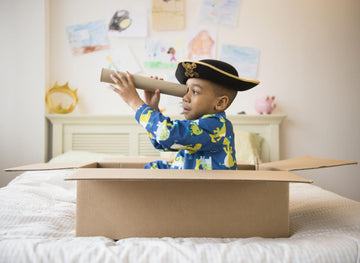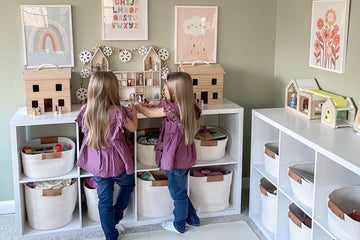Every parent knows the joy of watching their child discover new things, but there's something truly special about seeing them dive into independent play. It’s like watching a tiny explorer set out on their own adventure, equipped with nothing but their imagination. Encouraging independent play is a fantastic way to help your child develop confidence, creativity, and problem-solving skills. Here’s how to support and nurture this important aspect of their growth.

1. Create a Safe and Stimulating Environment
A child’s play space can greatly influence their willingness to engage in independent play. To encourage exploration, make sure their environment is safe and inviting. Create a designated play area that is free from distractions and hazards. Use soft mats or rugs, and ensure that any toys or materials within reach are age-appropriate and safe.
Consider incorporating a variety of open-ended toys that spark creativity. For example, a set of Wooden Rainbow Stacking Toys can offer endless possibilities, from building towers to creating patterns. The goal is to provide an environment where your child feels comfortable and inspired to explore on their own.
2. Offer a Variety of Toys
Having a range of toys available can keep your child engaged and motivated to play independently. Toys that encourage imaginative play, problem-solving, and creativity are especially beneficial. For instance, Wooden Puzzle Toy Blocks are perfect for children to experiment with, as they can build, stack, and create different structures. The variety ensures that your child has multiple ways to engage and discover, which keeps their interest high.
3. Set Up Play Stations
Creating specific play stations can help guide your child’s independent play. Each station can focus on a different type of activity, such as building, art, or sensory play. For example, a station with simple, interactive toys like a Bear Wood Busy Board can provide tactile stimulation and encourage problem-solving. By setting up these stations, you give your child a structured yet flexible way to explore various types of play on their own.
4. Encourage Exploration and Experimentation
Let your child explore and experiment with their toys without too much intervention. Resist the urge to direct their play or step in immediately if they encounter a challenge. Independent play thrives when children have the freedom to make their own decisions and learn from their experiences. This fosters a sense of autonomy and helps them develop problem-solving skills as they navigate their playtime.
5. Model Independent Play
Children often learn by observing, so it’s helpful to model independent play for them. Set aside time for your own activities and demonstrate how you engage with your hobbies or interests. By seeing you enjoy your own independent activities, your child will understand that spending time on their own play is both normal and enjoyable.
6. Praise Efforts, Not Just Achievements
When your child engages in independent play, offer praise that focuses on their efforts rather than just the outcomes. Comments like “I love how you figured out how to stack those blocks” or “It’s great to see you exploring on your own” can reinforce their confidence and encourage them to keep playing independently. Positive reinforcement helps build their self-esteem and motivates them to continue exploring on their own.
7. Be Patient and Consistent
Encouraging independent play takes time and patience. Initially, your child might need more guidance and support. Be consistent in providing opportunities for independent play and gradually increase the amount of time they spend playing alone. Over time, they will become more comfortable and confident in their ability to entertain themselves.
8. Incorporate Learning Opportunities
Simple toys with educational value can also support independent play. For example, a Wooden Shape Sorting Toy can help with shape recognition and fine motor skills while allowing your child to explore on their own. Integrating learning opportunities into playtime ensures that your child benefits from their independent play sessions both educationally and developmentally.
9. Provide Time for Unstructured Play
Allow for plenty of unstructured playtime where your child can use their imagination freely. Avoid scheduling every moment of their day and give them the space to engage in spontaneous play. Unstructured time promotes creativity and allows your child to develop their interests and preferences at their own pace.
10. Encourage Social Play When Appropriate
While independent play is crucial, social interactions are also important. Encourage your child to play with others when they are ready, as this can enhance their social skills and provide a balance to their play experiences. Playdates, group activities, and cooperative games can complement their independent playtime and contribute to their overall development.
---
Encouraging independent play in young children is about creating the right environment, providing engaging toys, and allowing them the freedom to explore and experiment on their own. By setting up safe, stimulating spaces and offering a variety of play options, you help your child build confidence, creativity, and problem-solving skills. Remember, fostering independence takes time and patience, but the benefits are well worth the effort. Embrace the adventure of watching your child grow and discover the world through their own eyes, one play session at a time.






